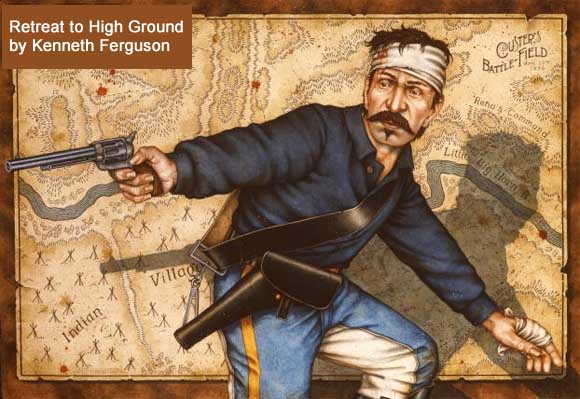|
||||||
Bruce Brown's 100 Voices... Edward Pigford's Story of the Battle
THE STORY OF PRIVATE EDWARD PIGFORD SAYS SGT. O'HARA was hit on the skirmish line and not killed. When Pigford left the skirmish line O'Hara called to Pigford "For God's sake don't leave me." Pigford says the skirmish line was no sooner formed than it broke up. He personally fired only 4 or 5 shots. Says O'Hara was killed about 40 or 50 yds. from timber. Says Bill Meyer was killed by an Indian on a horse who had followed to the east side. At this time there were several Indians who had followed to west side but did not cross the river after Reno's retreating soldiers. Pigford turned to fire at this Indian, but he got behind a rock and was taking aim at him (Pigford). Says Co. M (Capt. French) went all way to Edgerly Peaks, from which could look down in direction of Custer Ridge. Says at first when looked over toward Custer ridge the Indians were firing from a big circle, but it gradually closed until they seemed to converge into a large black mass on the side hill toward the river and all along the ridge. He thinks what they saw was the last stages of the fight. His description of what took place at Edgerly Hills while Co. M was there seems reliable. Among other things he said the appearance of Indians coming from Custer Ridge toward Weir hills looked as thick as grasshoppers in a harvest field. Capt. French's nickname among enlisted men was "Tucker." Pigford says the Indian killed near Co. H line was one who had charged up and stopped there. The soldiers had fled to north end of Benteen's line. Every little while this Indian would rise up and fire. Once when he rose up he exposed the upper half of his body, and Pigford taking deliberate aim, killed him. Says one ruse the Indians got up to draw fire of soldiers on Reno Hill was a stuffed dummy in buckskin tied on a pony and the pony lashed up and driven over the ridge toward the soldiers and then turned loose. As the pony ran around, the soldiers for quite a while poured shots at him and his rider at long range. Says that while men were getting water on p.m. June 26, he with others was guarding the route and saw an Indian in a tree on west side of river. He put up his sights and fired at him and saw him fall. On June 27 they found this Indian with a wound in his thigh and his neck broken. He had fallen out of the tree when shot and apparently had landed on his head and died there. Apparently none of the Indians had found him. Walter Mason Camp's Notes: 1 Walter Camp field notes, folder 47, BYU Library. Edward D. Pigford, born in Allegheny County, Pennsylvania, enlisted on September 13, 1875. He was wounded in the right hip in the retreat from the valley fight on June 25, was slightly wounded in the right forearm by a small caliber bullet on June 26, and was discharged on October 15, 1876. His story, "Fighting With Custer," as told to Earle Forrest, appeared in the Washington, Pennsylvania Morning Observer, October 3-19, 1932. Pigford died on December 6, 1932, and was buried at Dravosberg, Pennsylvania. Custer in '76: Walter Camp's Notes on the Custer Fight, edited by Kenneth Hammer, Brigham Young University Press 1976 p 143 - 144
Edward Pigford's account is interesting for the glimpse it provides of the Indians' battlefield tactics, specifically their use of a stuffed dummy to draw the American soldier's fire. -- B.B. |
||||||













